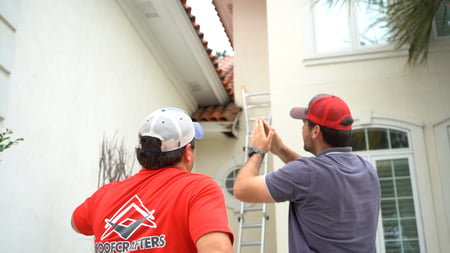
Buying your first home is a milestone. You’ve signed the papers, gotten the keys, taken a thousand photos in front of the home, and now you’re officially responsible for everything inside and outside that front door. It’s exciting… and also a little terrifying.
Amidst all the new-home checklists and furniture shopping, RoofCrafters knows that one crucial element is often overlooked by first-time homeowners: the roof. And unfortunately, the roof doesn’t care if you’re a rookie. Leaks, rot, missing shingles, clogged gutters… these things don’t wait until you’ve fully settled in.
The good news? You don’t need to be a roofing expert to protect your investment. You just need to know the basics, and we’ve got you covered. Let’s run through everything you need to know about your roof as a first-time homeowner, shall we?
Why Your Roof Deserves More of Your Attention

Let’s break it down: your roof takes the brunt of the sun, rain, wind, and hail. When it’s in good shape, you don’t even think about it. When it’s not? You’ll notice, and fast. A leaky or damaged roof can lead to costly repairs that go far beyond a couple of loose shingles.
Think water-stained ceilings, mold, ruined insulation, warped wood, or even electrical issues. And the kicker? Most roof damage happens slowly, over time. So the sooner you get in the habit of keeping tabs on your roof, the more you’ll save, both in money and stress.
9 Essential Roofing Tips Every First-Time Homeowner Should Know

Here’s your no-fluff, straight-shooting guide to getting roof-smart as a new homeowner:
1. Know What Type of Roof You Have
Asphalt shingle, metal, tile, slate, flat, pitched, every roofing material and design comes with its own strengths, weaknesses, and maintenance needs. Look up your home’s inspection report or ask your realtor if you’re unsure what kind of roof you have.
A metal roof may last 40+ years with minimal maintenance. Asphalt shingles? They might need attention every 10–15 years. Understanding your roof type sets the foundation for all the tips that follow.
2. Check the Roof After Major Storms
You don’t need to climb up there (and unless you’re trained to, please don’t). Just do a visual inspection from the ground with binoculars or use a drone if you have one. Look for:
- Missing or curling shingles
- Bent or detached flashing (those metal strips around chimneys and vents)
- Debris buildup in valleys
- Sagging areas or standing water on flat roofs
If anything looks suspicious, call a roofing professional. Fast.
3. Schedule a Roof Inspection (Even If the Seller Already Did One)
Yes, your home inspector may have checked the roof during the buying process, but a dedicated roofing inspection is far more detailed. Schedule one within the first 6–12 months of owning your home, especially if the roof is older than 8 years.
Bonus: Many roofing companies offer free inspections. Just make sure they’re reputable, licensed, and insured.
4. Keep Your Gutters Clean (Seriously)
Gutters are your roof’s sidekick. They quietly keep water moving off your roof and away from your foundation. When they’re clogged, water backs up under the shingles or spills down the side of your house, eroding your landscaping and potentially damaging your siding. Clean your gutters at least twice a year, or more if you have lots of trees nearby.
5. Trim Overhanging Branches
Tree limbs may look pretty swaying above your roofline, but they’re a major hazard. During storms, they can break and cause impact damage. Even smaller branches can scratch or wear down shingles over time. Not to mention leaves = clogged gutters. Keep branches at least 6–10 feet away from your roof whenever possible.
6. Don’t Ignore the Attic
We get it, the attic isn’t the flashiest part of your home. But it’s one of the best places to catch early signs of roof trouble. Every few months, grab a flashlight and peek around for:
- Damp spots on insulation or beams
- Mold or mildew
- Light shining through the roof boards
- A musty smell
These are all red flags. The sooner you catch them, the cheaper and easier the fix.
7. Understand Your Roof’s Age and Warranty
Find out how old your roof is ASAP! This can usually be found in your home inspection report. Roofing materials have a lifespan, and it’s better to plan for a future replacement than to be caught off guard.
Also, check if your roof is still under warranty. Some roofing systems have transferable warranties that may still be active after a home sale.
8. Know the Signs You Need Roof Repairs
Leaks aren’t the only indicator that your roof is in trouble. Keep an eye out for:
- Granules in your gutters (they look like coarse black sand. This means your shingles are deteriorating)
- Stains on ceilings or walls
- Higher-than-usual energy bills (your attic could be poorly ventilated or insulated due to roof damage)
- Mold on exterior walls
The sooner you act, the more you can avoid full-scale replacements or interior damage.
9. Budget for Roof Maintenance and Repairs
Roofs don’t last forever, and they’re not cheap to replace. It’s a good idea to set aside a little money each year in a home maintenance fund specifically for roof repairs, even if it’s just a couple of hundred bucks annually.
Why? Because an emergency roof leak during hurricane season or a surprise winter storm can put a serious dent in your savings. Planning ahead = peace of mind.
Bonus Tip: Build a Relationship with a Roofing Pro

You don’t need to become best friends, but having a trusted roofing contractor on speed dial makes all the difference when something goes wrong. Ask your neighbors for referrals, check online reviews, and don’t be afraid to ask questions about licensing, insurance, and warranty coverage before you hire anyone.
Stay One Step Ahead of Roofing Trouble
Owning your first home comes with a learning curve, and your roof is a big part of that journey. The good news? With a little proactive care and basic knowledge, you can avoid most roofing disasters before they start.
So while you’re painting walls and hanging curtains, don’t forget to look up. A little attention now can save you from major headaches later. And trust us, future you will be grateful you took the time to get roof-smart.
At RoofCrafters, we help first-time homeowners across the Southeast feel confident and protected. Whether you need a free inspection, minor repairs, or just some expert advice, we’re here to help. Be sure to hit that big red button down below!
My name is Cassie, and I’m the Content Manager here at RoofCrafters. I was born and raised in Chicago, Illinois, and made my way out to Florida post-college graduation. I’m incredibly passionate about writing and creating valuable content that helps others with the collaboration of my marketing team. When I’m not working, I enjoy shopping (a little too much), spending time at the beach, and reading!



